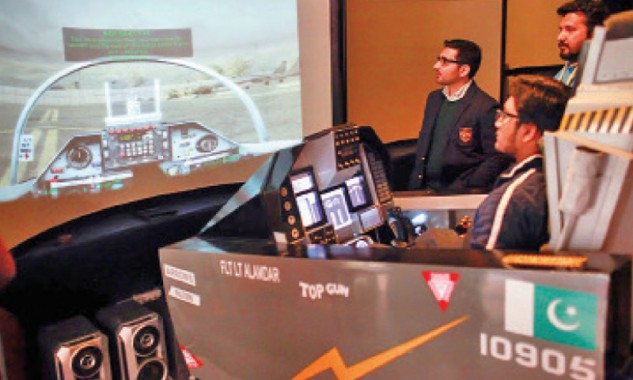
ISLAMABAD: About 20,000 feet above the Arabian Sea, the co-pilot taps his keyboard and brings up a map of the Sindh coastline on the heads-up display. The pilot shakes his head as his partner hits a few more keys.
Suddenly, the landscape changes to arid desert and we’re above the Sindh coastline. The pilot then proceeds to roll the aircraft.
Fully inverted, he turns to his audience and says, “See, for a moment there, you could experience the change in sensory perception; your instruments are telling you you’re inverted, but the brain thinks otherwise. This is a real problem, even for the most experienced of pilots.”
This may sound like a day in the life of an elite trainee at the famed Top Gun school in Fightertown, USA. But for a few hundred rupees, anyone can experience what it’s like to engage the afterburners on a military grade fighter plane, or cruise between international airports aboard a Boeing 777.
Thanks to Thrust Factor — Pakistan’s first indigenously produced flight simulator — anyone can fly an F-16 without going to a flying school
From the inside of the main cockpit, designed as an exact replica of the JF-17’s driving seat, Daniyal Masoom demonstrates what he calls his pièce de résistance, the most advanced flight simulation platform ever designed in Pakistan.
It’s a little like being in The Matrix, you strap in and are immediately transported several thousand feet above sea-level. The roar of the fighter jet’s engines bellows from the speakers as the instrument panel lights up. From the moment you gain control of the aircraft, you’re hooked.
The partnership that spawned this technological marvel was formed in Dec 5, 1997. “That’s the day we enrolled at the PAF Academy, Risalpur,” says Syed Mohammad Raza, the other half of the duo behind Thrust Factor. A technically gifted engineer and mathematician, Raza had already developed a working prototype of the simulator platform by the time the two men decided to collaborate.
While they have no plans to abandon their day jobs yet, both men confess that designing simulators is their real passion.
Although they still call themselves a start-up, the duo have already had great success marketing their wares to foreign buyers with deeper pockets. A fully functional version of the cockpit installed on the sixth floor of the Safa Gold Mall is already in place in Qatar, with several other projects in the pipeline.
Thrust Factor is more than just a flight simulator. In video gaming terms, the system that Daniyal and Raza have designed can ‘talk to’ most video games available on the market. The simulators can even be linked via LAN to enable multiplayer gaming.
They have integrated everything from driving simulators to Moto GP games, and there is even talk of a fighting simulator.
“Players will strap motion sensors to their hands and feet and then go toe-to-toe. It’s gonna change the way people think about playing video games.”
The platform they’ve designed, both hardware and software, is completely indigenous. “We’ve made sure that every single part, every bit of raw material is something that can be easily found in markets of Lahore, Karachi, Islamabad or Multan,” says Raza.
Asked how they get the simulator to replicate the in-game movements, Raza proudly explains his ingenious solution to the problem of clumsy hydraulics. “It’s an electronic actuator that we designed ourselves. The patent is currently pending,” he tells us with much aplomb.
The result of his efforts is a bumpy yet realistic ride. “During a race, a driver will experience up to 3Gs. We want our users to experience at least half that, so that when they get out, they feel physically exhausted,” he says.
Starting out with Microsoft Flight Simulator X, the two have now upgraded their system so that it is compatible with XPLANE, a hyper-realistic flight simulator that is used by many militaries of the world to train pilots. Intuitive and easy to use even for the lay-man, Daniyal says that some of their best customers so far have been pilots. “At our last location, we had a group of PIA pilots who would come and fly 777s for hours and hours. They are now our biggest fans on Facebook.”
But this, Raza assures us, is just the beginning. They have already scaled up their R&D operation and are moving their lab from its humble 2-kanal confines on Adiala Road to a purpose-built facility near Burhan. “Money is a by-product of our success,” Raza says, but Daniyal is quick to add, “We’d like a lot of by-product.”
The next stop for both engineers is a platform that people can buy and install at home. “Something that costs Rs50,000-60,000 and can be connected with most gaming consoles.”







This is amazing!